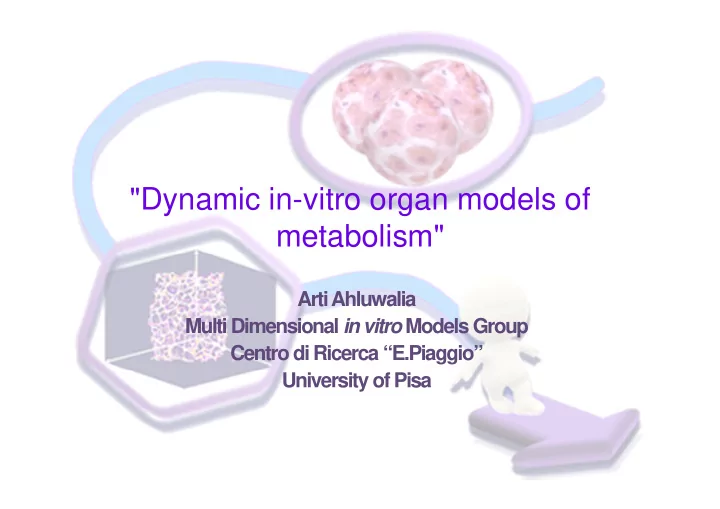

"Dynamic in-vitro organ models of metabolism" Arti Ahluwalia Multi Dimensional in vitro Models Group Centro di Ricerca “E.Piaggio” University of Pisa
100 years on, what’s missing? 1. Cells do not live on 2D plates…. 2. Stationary conditions do not exist in-vivo…. But in current in vitro systems kinetics are overlooked, usually the steady state behaviour is observed (eg 24 hour responses). 3. Cells do not live in isolation but are surrounded by a complex network of signals relayed by the bloodstream….
Why do we need better ivms? � To study systemic responses in a piecewise manner � To understand cross-talk and multiple pathway Homer, a 2D static mechanisms culture system is too simple to mimic the It doesn’t � Models for drug testing and for evaluating systemic native environment… matter Peter, side effects it’s SIMPLE! � To develop disease models � To develop personalized therapy based on gene and disease specific models � To reduce animal testing by developing more reliable and realistic human models
Our approach : Organomics � Several modular organ models can be connected in series or parallel through an inter-connected culture system , reproducing physiologically relevant multi- organ models for organomics (study of organ crosstalk ) Wiki/organomics
Nutrient Metabolism Hi fat! How are Hey guys do you? your job! I can’t handle the FFA’s so fast Too much fried Oh the shear food last stress of it all! night
Can we recreate this circuitry in-vitro ? Can we recreate metabolic homeostatsis and simulate effects of nutrient imbalance in vitro ?
Basic Design Rules • Select relevant cell/tissue types • Assemble in 3D scaffolds if appropriate • Select appropriate culture media • Scale cell numbers by rational and iterative design • Design connectable bioreators • Optimise fluid residence times and flow rates • Select appropriate controls and end points • Build circuit complexity one tissue @ a time
Modular Bioreactor chambers (MmCB) Mazzei et al, 2010, Biotechnology & Bioeng. , Vozzi et al., Biotceh & Bioeng. 2011, Vozzi et al Tissue Eng Part A. 2009 , Guzzardi et al. Tissue Eng 2010,
Hepatocytes remain well differentiated and functional dynamic Higher density Increased vitality Increased metabolic competence 3D dynamic Vinci et al. Biotech. J, 2009, 2010, 2011,
Effect of flow on detoxification genes
Effect of flow rate
Endothelial cells control LFC Human endothelium FLOW brings about Elongation CSK rearrangement NO increases Endothelin decreases Vozzi et al. Biotech & Bioeng. 20111 Laminar flow module
Equivalent circuit for nutrient metabolism Systems Analysis Bottom-up engineering approach
Visceral circuit Down scaled and reduced to essential features of central metabolism
The new modular system Hepatocytes on Partially microfabricated digested 3D scaffold adipose tissue LFC , monolayer of endothelial cells Cell ratios are scaled using allometry
ONE-WAY (individual cultures) Albumin Glucose Urea FFA TGA Glycerol Alanine Lactate IL6 E-Selectin Adipnectin TFG β CRP Iori et al. Plos One, 2012
TWO-WAY (increase cross-talk) THREE-WAY (add hepatocytes as regulators) TWO WAY (Endothelium +Adipose tissue) ×Hyperlipidemia, hypogly- cemia THREE WAY (Endothelium +Adipose tissue+hepatocytes) � GLUCOSE and LIPID HOMOEOSTASIS
Clincal observations • Chronic Hyperglycemia is linked to insulin resistance • Adipogenic cytokines (e.g. IL6) implicated in endothelial dysfunction (E-selectin is a precocious marker of EC stress ) Challenged Model � fasting state, normoglycemia, no Insulin � post absorptive resting state, normoglycemia, low Ins � diabetes type 1, hyperglycemia, no Insulin � diabetes type 2, hyperglycemia, low Insulin
Summary: challenged 3-WAY model Systemic and endothelial inflammation in the presence of high glucose. Modulated by insulin 350 250 % variation 150 Glucose E-selectin 50 IL-6 FFA Fasting Post Diabetes 1 Diabetes 2 absorptive -50
Obesity in vitro 35% 25% 12% To investigate the effect of increasing adiposity on maintainence of homeostasis and systemic inflammation in-vitro
Preliminary results Control 12% 25% HUVEC vWF expression with increased adiposity 35% LPS
Main Results •All 3 cell types are necessary to obtain metabolite regulation •Hepatocytes are the master regulator IN HYPERGLYCEMIC CONDITIONS •Dysregulation of metabolites •Endothelial specific stress @high glucose conc. •Systemic stress is significantly increased at high glucose concentrations only when insulin is absent IN PRESENCE OF EXCESS ADIPOSITY •Preliminary tests on 2 way cultures: endothelial stress increases with adiposity
Thanks THANK YOU!
Thanks A. Tirella, T. Sbrana, M. La Marca, S. Giusti, G. Mattei, D. Cei, V. Di Patria,, B. Vinci, D. Mazzei, N. Ucciferri E. Iori & A.Avogaro (Univ of Padova) F.Vozzi, C. Domenici (CNR)
Recommend
More recommend